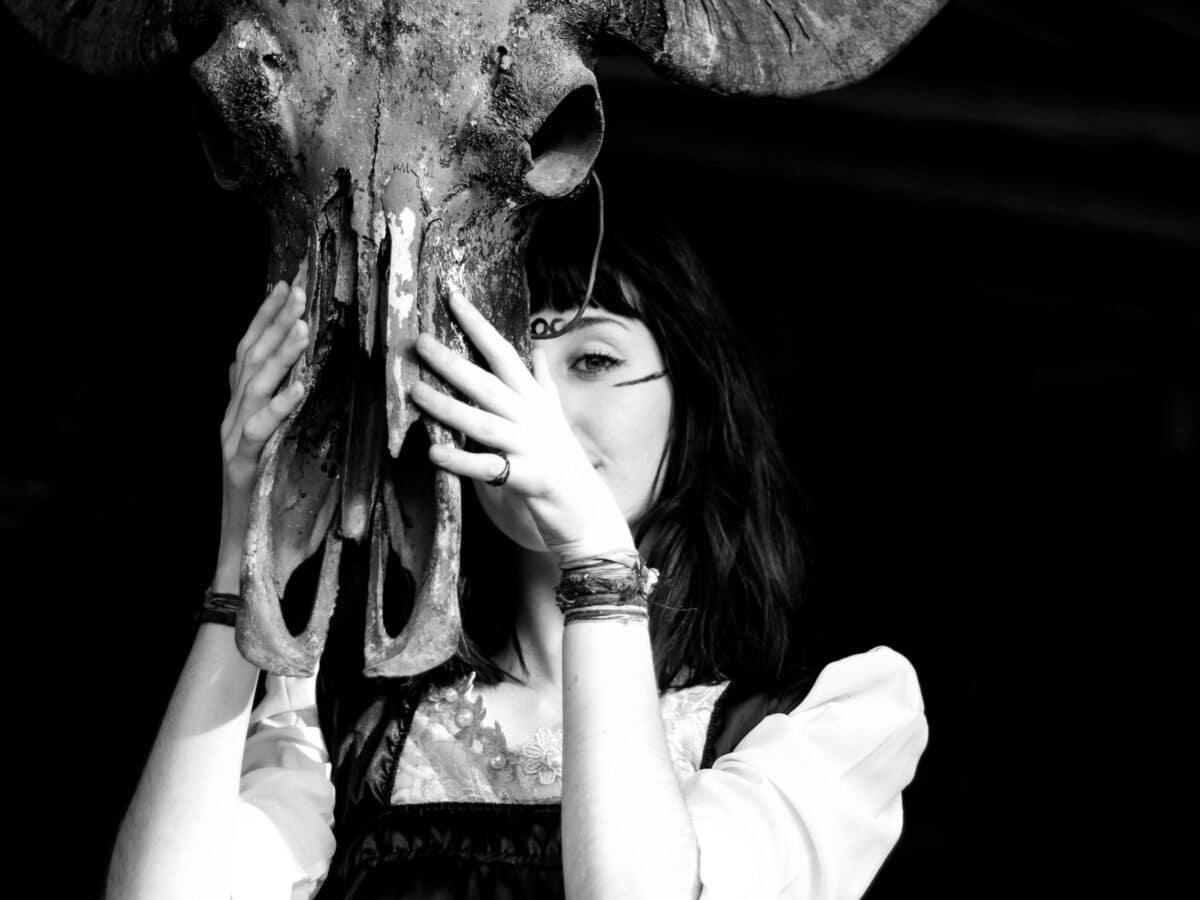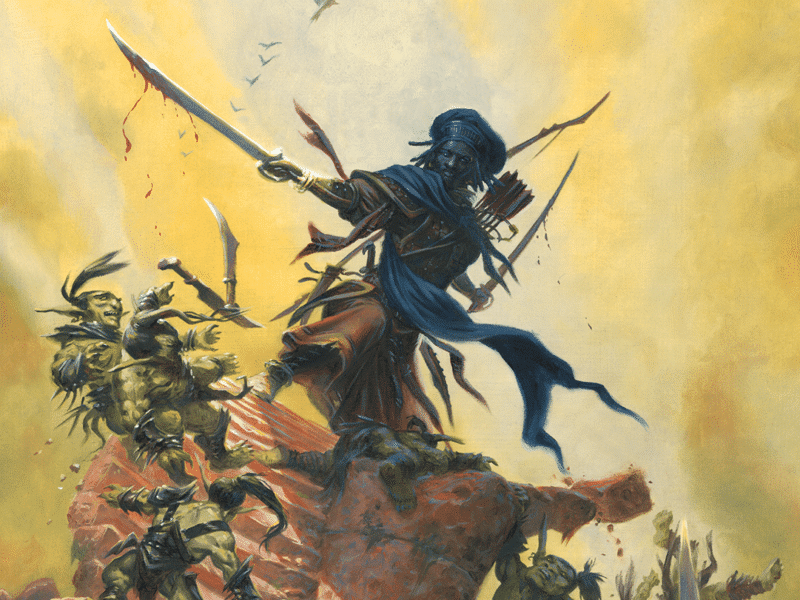There are scares aplenty in the world of Dungeon & Dragons. After all, the game is essentially about pitching a group of mortal (if imaginary) adventurers against all kinds of monsters. The core rule books and the numerous third-party modules available today provides a Dungeon Master with a massive arsenal of horrific creatures to throw at the player characters. And the vast majority of these beings are, by default, frightening. This is what makes them monsters in the first place! Armed with a few weapons and a battery of spells, the would-be heroes will face waves of such monstrosities, over and over until the characters either are retired or – more commonly – suffer a sticky end at the hands (or claws) of some kind of lethal being. So it can be argued that D&D is, at heart, a game of frights, or at least many tense and unsettling moments.
But running a whole adventure or even a campaign themed specifically around horror – well, that’s a different beast altogether. Making these as effective – not only scary, but also memorable and fun – as possible requires plenty of preparation, as well as thought going into what aspects to highlight (and what to tone down). It’s easy to believe that more of everything is better in order to ramp up the fright-factor, but good horror-based quests and settings are built on much more than a torrent of nastiness and gore galore.
This article sums up some handy advice for how you can make sure to have your players sitting at the edge of their seats when you launch a campaign intended to make their skin crawl. Ready read on? Then light your lantern, draw your sword, make your last wishes and prepare to descend into the dark realm of horror roleplaying tips!

What do the players want?
Let’s start with the most important part: checking in with your group. If you already know all your players well, this might not be necessary unless you plan to take your adventure into a much darker place than where you usually go. However, if you’re preparing to run a campaign for one or more new players (as in people who you don’t know well, rather than people who are new to the hobby), then it’s highly advisable to talk to them first about their expectations and preferences. Some might argue that anyone who comes to the hobby already know – or should know – what they’re in for, and that it’s all imaginary horrors anyway. However, the default setting of Dungeons & Dragons is, to say the least, broad and whimsical. It’s menagerie of monstrosities contains creatures that range from outright silly and harmless to decidedly discomforting and chilling. Different people will perceive these in varying ways and, critically, intensity. An event or creature that causes mild disgust in one player might create a sensation of vivid terror in another. This is true for all types of adventures, but it’s especially important to keep in mind when running a horror-themed one.
For this reason, before you bring on the flesh-eating spiders and the zombie children, have a word with the players about what you’re planning, and ask if they have any definite no-go zones. There are plenty of suggested templates and guidelines with questions and conversation topics available for free online. It might feel overly cautious, but more than one DM has been surprised by what their players have shared – sometimes, even long-time friends have specific themes or topics that they truly abhor but haven’t told anyone about.
Eerie ambience
Another part of recommended preparations includes the all-important ambience in the real world (as opposed to the in-game one). In our group, we normally have lit candles and soft background music (it became a tradition some thirty years ago). If the adventure we’re playing is in the genre of horror, the lighting and the music becomes all the more important! Glaring strip lights above and upbeat disco tracks in the background are no one’s friend when trying to create a spooky vibe. I realise that for some groups, their circumstances are hard to alter – for example, if your D&D club plays in a brightly lit shop with customers milling around just a few steps away, there’s only so much one can do. But if you have the chance, spend some time to arrange an environment that fits the adventure. Dim the lights, light a few candles, and find a good ambient playlist or long track (YouTube is brimming with tunes custom-made for roleplaying sessions and suitable for every conceivable theme).
Dreadful descriptions
On to how a DM can make the players shiver in their socks and worry about their characters’ fates. So you’ve cooked up the most unsettling monster imaginable. How to present this to the players and get the appropriate reaction? This usually begins with the descriptions – in other words, informing the people around the physical or virtual table about what their characters experience (and, as we’ll soon find , what they don’t see or hear!).
Normally, those who enjoy playing roleplaying games such as D&D have great imagination. This is a given, as the nature of the game relies strongly on being able to visualise scenes. But if you’re running a horror adventure, you want to make sure that the players have the right kind of images in their heads. This can be done simply by avoiding generic descriptions or through sprinkling in a few additional words. What’s important is what kind of words that you add.
For example, let’s say that you’re running an adventure in which the adventurers discover a building situated in the middle of a huge swamp. This could be described as follows:
The DM: “You find a house in the middle of the swamp. The house is made of wood and has three storeys. All the doors and shutters are closed. What do you do?”
If the lighting is low and you’ve got the Bram Stoker’s Dracula soundtrack running in the background, the players might conjure an image of the house as a bit eerie. However, compare the above with this narration:
The DM: “As you trudge through the gloomy swamp and its knee-deep muck, you spot a strangely regular section farther ahead. After a few more steps, you see that it’s a house, surrounded by rotting reeds and crooked trees. Judging by its disintegrating woodwork and peeling paint, the house is at least a hundred years old. A broken weather vane hangs askew from the steep rooftop next to a sooty, moss-covered chimney, In the cracks between the shutters that block the arched windows is only darkness. The foul air is filled by a thick silence, punctuated only by the occasional buzz of fat flies. It may be your imagination, but the reek of the swamp is stronger here.”
Such a passage requires more work from the DM, but it does two jobs: firstly, there is more words that draw attention to the ominous aspects of the building and its surroundings, and secondly, the length of the description means that there’s more time for the players to start question the wisdom in approaching the house. Put differently: a slower pace makes for a more threatening imaginary image.
Show, don’t tell
With the risk of confusing things for a moment, I’ll now contradict what I just said above by claiming that sometimes, not describing places or beings can make them all the more scary. What I’m suggesting is that there are nuances to descriptions, and also moments when leaving them out altogether is highly effective. For example, not being specific when describing what a character senses can jumpstart the player’s imagination and have it amplify the dread.
Let’s say that the adventuring party is about to examine an abandoned tavern. They’re already on edge as they’ve heard rumours about terrifying screams coming from the building at night, and there might also be stories that mention dark deeds that have taken place there before it fell into disuse. As the adventurers sneak into the building, one of them ventures into a dim room when they’re suddenly feel a cold fluid drop from the ceiling and splash against their face. Now, this could be harmless water – but that’s not what the player will assume, and likely not their character either.
Then there are moments when saying nothing at all about a creatures’ appearance for as long as possible has tremendous results. This tip uses the trick of countless ghost stories and horror movies in not revealing the monster until the very end. Instead, let the effects of the monster (or specter, vampire, ghoul, house-sized spider – whatever being you’re using) be on full display, and have them become increasingly dramatic as the adventure progresses! Start with footprints in the dust or eerie noises, move on to claw marks on walls and blood splattered on floors, then bodies with grievous wounds and stricken expressions. Consider films such as Alien or Cloverfield: we don’t get to see much of the actual monster until the very end, and to great effect.
No way out
Another handy and straightforward tip is to stick the characters in a place that they can’t readily escape on in which they are totally stuck. The lack of an easy escape route is an immediate stress factor that is guaranteed to make the players concerned. This situation can be signposted long before the characters are trapped, for example by letting them know that they’ll be entering a cave with narrow passages that take minutes to crawl through before they reach their goal. Alternatively, the adventurers can find themselves without an exit without warning: “You turn around and find that the path down which you travelled has vanished! The only way ahead is into the foggy dale…”
This evil trick works on all scales. If the characters are in a house, the doors that lead outside can slam shut and become impossible to open. Should the adventurers be in a town, maybe they wake up to find it encircled by a magic fog that prevents anyone from departing.
I can’t see a thing!
There is one primal fear that make most people reflexively shrink back in their chairs: darkness. The absence of light is rarely a problem in D&D as its rules are written, given there are several spells that provide illumination – and to boot, every other playable race has darkvision. This means that it’s difficult to let things hide from the characters in gloomy halls or unlit caverns without changing the rules a little – but on the other hand, it’s totally fine to tweak D&D a little, if it’s done sparingly! For example, maybe the adventurers are exploring a dungeon in which the shadows magically grow ever deeper. First, their darkvision works as usual, but as they wander farther into the complex, they find that they can see progressively less, and eventually nothing at all.
Also, characters with darkvision can be unable to see their surroundings or enemies because of other limitations. Perhaps the catacombs that they’re investigating are filled with an unusually thick mist? Maybe streets of the town that the dragon and its loyal kobolds are attacking have become obscured by dense smoke? Alternatively, you can let monsters and other threats have special powers that make them impossible to see even by characters who have darkvision, by being invisible or blend in perfectly with the environment. I suggest that this kind of trickery isn’t overdone as characters with darkvision often have this feature to balance another weakness, but it can be incredibly useful for reinforcing a sense of dread.
Stick to the theme almost always
Lastly, a point on the importance of not letting horror-themed D&D adventures or campaigns end up too one-dimensional. Even when the ambition is to make the players nervous and fear for their characters, moments of happiness and lightness are fine – they’re even beneficial, as a constant onslaught of darkness can get tiresome. It’s all a matter of picking the right kind of contrast and presenting it at the right moment.
For example, maybe the adventurers have spent hours searching a derelict and terrifying hospital, in which they’ve made a variety of hideous discoveries and encountered several vile monsters. Suddenly, they find a beautiful painting of a serene landscape that brings to their minds a sense of tranquillity and wonder, a notion that somewhere beyond this realm of horror is a place where all is well. In other words, a brief glimmer of light in the darkness. A contrast of this kind serves two purposes: it provides a break from constant bleakness, and because it’s something likable, it makes the surrounding horrors appear all the more dreadful.
So don’t hesitate to add a flash of exquisiteness or a moment of joy in a fear-inducing D&D setting, just take care not to depart from the sense of horror too much so that the general mood is dispelled.
Those were a few tips that might help to make your next campaign a tad scarier! And there are many more tricks that one can use, so keep exploring the darkest alcoves of the internet – and your imagination – for more ideas!







